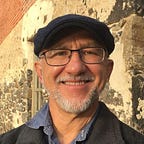Emerging Into Climate Action
I am really upset by what’s happening to our climate, and I want to do something about it. To quote an iconic movie: “I’m mad as hell, and I’m not going to take it anymore!” (this really dates me — you can look it up). How exactly I’m “not going to take it” is something I’m working out, but this blog will be a part of it.
I make some efforts now, but I’m frustrated. You see, I am a college biology teacher, and for decades I’ve been talking to students about how humans are changing the climate by adding heat-trapping gases to the atmosphere, mainly carbon dioxide from burning fossil fuels. I show them the Keeling Curve documenting carbon dioxide rise since the year I was born (you can look that up too), and Michael Mann and colleagues’ Hockey Stick depicting temperatures way out of whack with the last thousand years.
I tell them about the consequences of this change, such as sea level rise, more intense storms, droughts and floods, and all the biological, economic, and social upheaval that results. I tell them it’s not far away or in the future, but in our face, here and now: As I write this, parts of the U.S. West have had the hottest week on record, with Phoenix recording almost a week over 115⁰F (46⁰C). Some places have even higher temperatures. Take, for instance, 118⁰F (48⁰C) — in the Siberian Arctic! Meanwhile, as the costs of treating our thin atmosphere like an open sewer rapidly accumulate, I find myself still standing in front of 18-year-olds, who somehow never age, and my song remains the same. I feel like a broken record, in a kind of surreal Groundhog Day scenario immortalized in another great film. (No need to look that up, right?)
Things have changed incrementally. The reality and drivers of climate change, and the need for urgent action, have achieved virtually unanimous consensus among scientists, governments, and organizations throughout the world; what we need to do has never been clearer, and happily our ability to do it has grown exponentially. Yet we have done so little in comparison to the magnitude of the problem. Indeed, fully half of the planet-warming gases emitted in all of human history have occurred since one pivotal heat-soaked summer of 1988, when climate change made the cover of Newsweek. This is how humans have responded to the crisis. Not.
Ironically, unlike problems like mysterious emergent diseases, we know what the problem is and how to fix it. Public concern has increased dramatically in recent years, even in the laggard U.S. My students, perpetually 18 years old, have become more aware as well, but many express resignation that it’s just going to happen and we’ll have to adapt. I tell them: That’s pretty much impossible. I show them that humans evolved in temperatures nothing like where we’re headed, and that civilization developed within a relatively cold and stable temperature range we’re rapidly rising above (see accompanying graph). We are actively, consciously, moving ourselves to a foreign and inhospitable planet.
Why then, some ask, if we have an understanding of the problem, and the capability to fix it, have we not acted? Indeed. We have collectively made the choice to avoid doing anything, and now we have procrastinated so long that more extreme actions must be implemented with great urgency. As described by the Intergovernmental Panel on Climate Change, or IPCC, the rough plan is to halve greenhouse gas emissions by 2030 and achieve net zero carbon additions by 2050 to avoid temperature changes that we could not adapt to, with potentially catastrophic results. Mind you, there are really no precise deadlines or explicitly determined tipping points, but it’s clear that we need strong, decisive, and immediate leadership and action across all belief systems and borders, from villages to nations. We’re past the point of hoping for individual behavioral changes or counting on some silver-bullet or unproven technology. Our solution boils down to one word: Politics.
Ugh. I am not much of an activist or organizer, but I feel I must climb out of my academic burrow and bring an end to this Groundhog Day. I am sick of standing still in front of those students. I am setting out to get over my fears and move, and this blog will share my journey. I’m not sure exactly how it will unfold, but it will no doubt include policies to contain the massive loss of my beloved plants and animals and all other living beings. I imagine them perplexed and baffled as they struggle and sometimes fall victim to their altered home.
I’m not running for office or starting a non-profit or quitting my job (who can afford that?). I just want to do some small part to influence large matters of policy through officeholders and their work. I may not move mountains (or win over Andie MacDowell), but I can help prevent coal companies from moving mountains with the help of hundreds, thousands, millions of others. I have two children, many nieces and nephews, and, yes, all those students, who I do love as well. Perhaps you too are close to some fellow humans who will extend into the post-you future, and you have an interest in how things will play out for them . . . or even in how you might act to improve their odds. If so, follow this blog, and we’ll learn together. Time to look up, climb out, and cast a little shadow!
